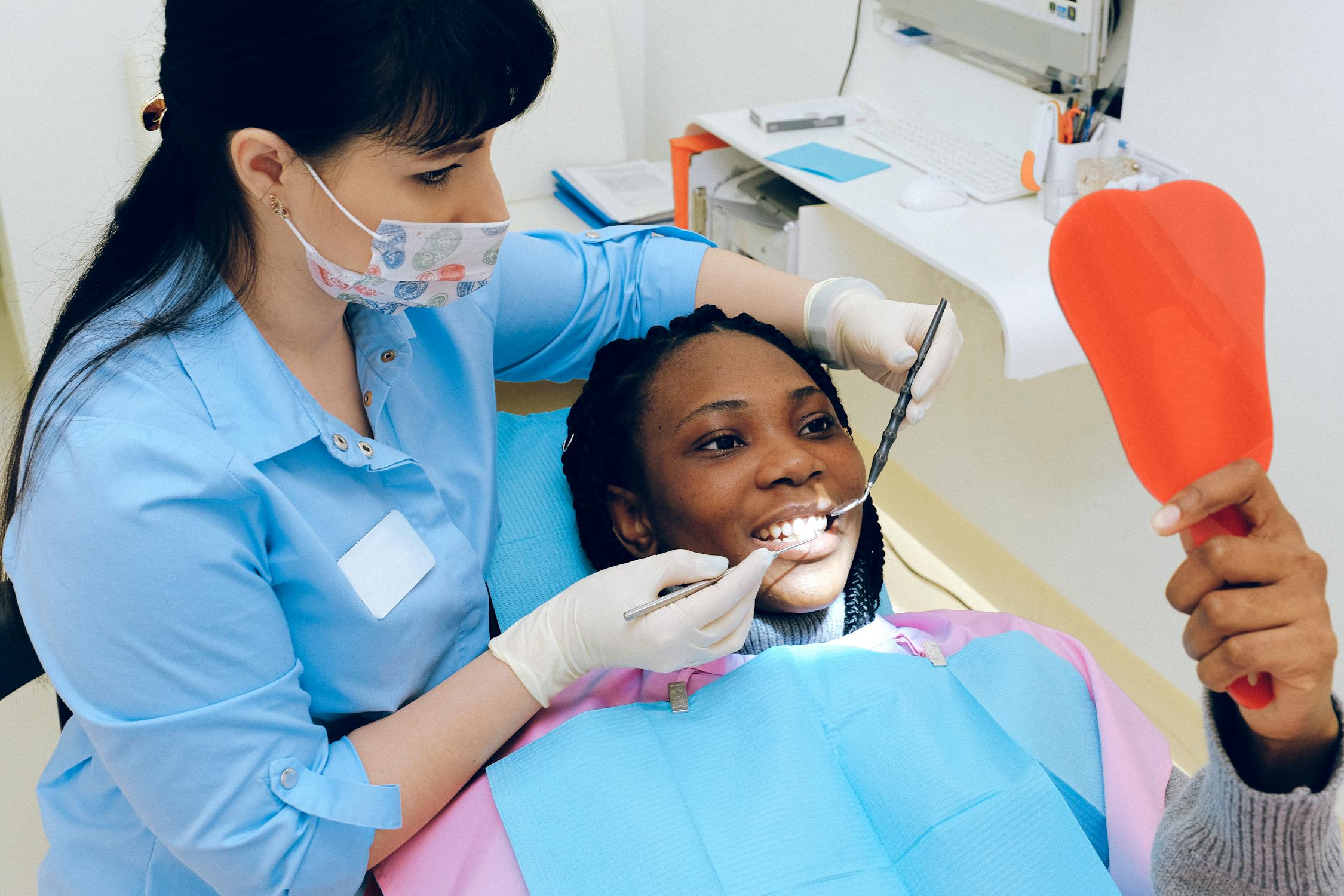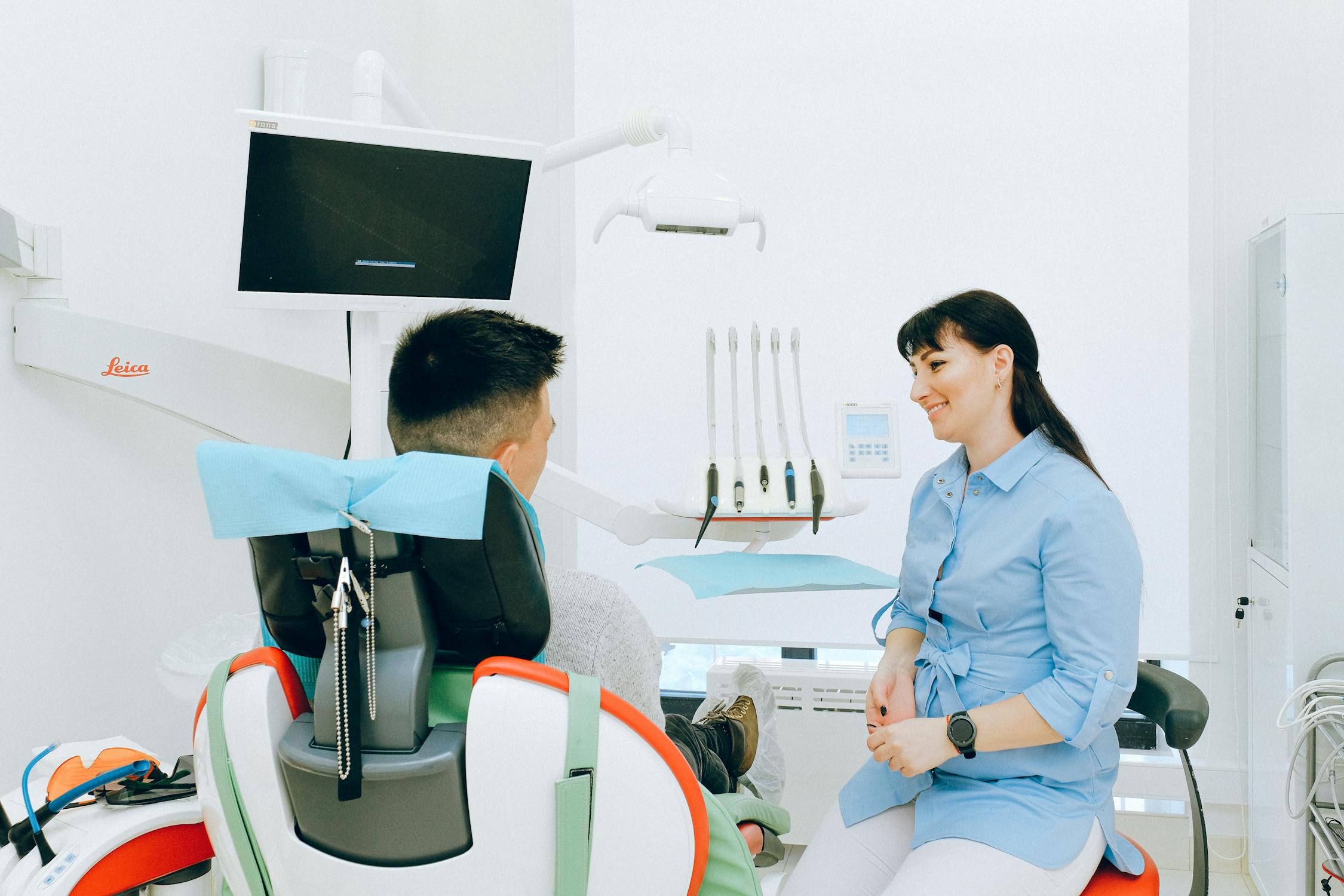Dentist Listening Practice: Real Conversation + Activities

Going to the dentist can be stressful — but it's also full of useful, real-life English you can practice. In this lesson, you'll hear a natural conversation between a patient and a dentist, then do three short listening activities to make sure the language sticks.
By the end, you'll understand everyday dental vocabulary, common phrases used during appointments, and how to follow spoken English in a high-pressure situation.
Round 1: Listen to the Real Conversation
Start by listening to the first part of the conversation once without subtitles or transcripts. Don't worry if you don't catch everything — focus on the overall flow.
Round 1: Vocabulary from the dentist conversation
Sort the words into the right groups.
Round 2: Put Events in Order
Now test your understanding of the sequence. Listen again and arrange the steps to match the conversation.
Round 2: Sequence the dentist visit (arrival → procedure → aftercare)
Drag or arrange each step into the correct order.
Round 3: Spot the Details
Listen for exact phrases and specific details — times, instructions, and how things felt. Click each item you hear.
Round 3: Detail check — instructions, sensations, and aftercare
Click each item when you hear the idea (wording may vary).

Understanding Cross-Cultural Communication at the Dentist
Going to the dentist in a foreign country involves more than just vocabulary — it's about navigating different cultural expectations around healthcare communication. These differences can create real misunderstandings that affect your treatment.
The Hidden Challenges
Personal Space and Touch
In North American dental practices, staff maintain professional distance until the procedure begins. They'll explain before touching you: "I'm going to examine your teeth now." In some Asian countries, dentists may begin examining immediately after you sit down, with less verbal warning. Mediterranean and Latin American dentists might use more reassuring touch on your shoulder or arm.
Pain Communication
- US/Canada: Expected to speak up immediately about pain. Raising your hand is standard.
- UK: Might endure more discomfort before speaking, using subtle cues like tensing up.
- Japan: May not verbalize pain directly, instead using non-verbal cues the dentist must notice.
- Germany: Very direct about pain levels, often using a 1-10 scale without prompting.
Consent and Questions
Anglo countries emphasize informed consent — you'll hear detailed explanations and be asked to verbally agree. In hierarchical medical cultures, questioning the dentist might seem disrespectful. Some patients from these backgrounds stay silent even when confused, leading to misunderstandings about treatment.
Visual and Non-Verbal Cues
What you see matters as much as what you hear:
Equipment Layout
- Modern Western clinics: Computer screens visible to patients, x-rays displayed openly
- Traditional practices: Equipment hidden from view to reduce anxiety
- Public health clinics: Multiple chairs in one room (common in some countries)
Body Language Meanings
- Direct eye contact: Professional in the West, potentially aggressive elsewhere
- Nodding: Agreement in most places, but "I'm listening" (not agreement) in Bulgaria/Albania
- Hand gestures: Open palms show honesty in the West, but pointing with fingers is rude in many Asian cultures

Essential Phrases for Every Stage of Your Dental Visit
At Reception/Booking
| Situation | What You'll Hear | How to Respond |
|---|---|---|
| Making appointment | "What seems to be the problem?" | "I have pain in my [upper/lower] [left/right] side" |
| Insurance | "Do you have dental coverage?" | "Yes, here's my card" / "I'll pay privately" |
| Wait time | "The doctor is running 15 minutes behind" | "That's fine" / "Should I reschedule?" |
| Forms | "Have you been here before?" | "No, first time" / "Yes, I'm a patient" |
During Examination
| What They Say | What It Means | Your Options |
|---|---|---|
| "Open wide" | Open your mouth fully | Open and say "Ahh" |
| "Bite down slowly" | Close teeth together gently | Close gradually, not hard |
| "You might feel pressure" | This won't hurt but you'll feel pushing | Raise hand if it becomes painful |
| "Rinse and spit" | Swish water and spit in sink | Don't swallow the rinse |
| "Turn toward me" | Rotate head to face dentist | Move slowly, ask if unsure |
| "Tap-tap-tap" | Testing nerve response | Say if any tooth hurts |
Describing Your Problem
Pain Types:
- "Sharp pain" = Sudden, stabbing sensation
- "Dull ache" = Constant, mild pain
- "Throbbing" = Pulsing pain with heartbeat
- "Sensitive to cold/hot" = Pain with temperature
- "Radiating pain" = Pain spreading to jaw/ear
Duration:
- "It's been hurting for [number] days"
- "It comes and goes"
- "Constant pain since [day]"
- "Only when I chew"

After Treatment
| Instruction | What to Do | For How Long |
|---|---|---|
| "Keep gauze in place" | Don't remove cotton/gauze | Usually 30-45 minutes |
| "No hot drinks" | Room temperature or cold only | 24 hours typically |
| "Soft foods only" | Soup, yogurt, mashed food | 2-3 days |
| "Don't rinse today" | No mouthwash or vigorous rinsing | First 24 hours |
| "Ice pack on and off" | 20 minutes on, 20 off | First day only |
UK vs US Dental Terminology
Understanding these differences prevents confusion when following instructions or reading forms:
Common Terms
| US Term | UK Term | What It Is |
|---|---|---|
| Novocaine | Lignocaine | Local anesthetic/numbing injection |
| Shot | Jab | Injection |
| Cavity | Tooth decay/hole | Damaged area in tooth |
| Crown | Cap | Artificial tooth covering |
| Root canal | Root treatment | Nerve removal procedure |
| Braces | Braces/train tracks | Teeth straightening device |
| Dental dam | Rubber dam | Sheet to isolate teeth |
| Gauze | Cotton wool/swab | Absorbent material |
| Tartar | Calculus | Hardened plaque |
| Periodontist | Gum specialist | Gum disease expert |
Procedural Differences
| US Practice | UK Practice | Impact on You |
|---|---|---|
| "Open wide" | "Open up for me" | UK often adds politeness markers |
| "You're all set" | "That's you done" | Different ways to say finished |
| "Does your insurance cover this?" | "Is this on the NHS?" | Payment system differences |
| "Schedule a follow-up" | "Book another appointment" | Scheduling vocabulary |
| "$50 copay" | "£25 NHS charge" | Payment structure |
Prescription Language
| US Says | UK Says | Meaning |
|---|---|---|
| "Take two Tylenol" | "Take two paracetamol" | Pain reliever (acetaminophen) |
| "Use Advil for swelling" | "Take ibuprofen for swelling" | Anti-inflammatory |
| "Prescription mouthwash" | "Medicated mouthwash" | Special rinse |
| "Antibiotic course" | "Course of antibiotics" | Infection medication |

Warning Signs: When to Return Immediately
Know these phrases — they indicate serious complications:
Excessive Bleeding
- "The gauze is soaked through"
- "Blood won't stop after 4 hours"
- "Bright red blood continuously"
Infection Signs
- "Swelling is getting worse"
- "Fever over 100°F/38°C"
- "Bad taste that won't go away"
- "Pus or discharge"
Nerve Issues
- "Still completely numb after 8 hours"
- "Tingling that doesn't stop"
- "Can't close my mouth properly"
Cultural Tips for Success
Before Your Appointment
- Write down your symptoms in English beforehand — pain makes it hard to remember vocabulary
- Take photos of any previous dental work or problem areas
- List your medications using generic names (they're more universal)
- Practice key phrases out loud: "The pain is on the upper left side"
During Your Appointment
- Use hand signals: Establish raising your left hand means "stop"
- Point to written notes if speaking is difficult with mouth open
- Repeat back instructions: "So no hot drinks for 24 hours?"
- Ask for written aftercare instructions if accent is difficult
Managing Anxiety in Another Language
- "I'm nervous about this procedure"
- "Can you explain that again slowly?"
- "I need a moment"
- "Is there another option?"
- "What are the risks?"
Remember: Medical professionals are used to treating anxious patients and non-native speakers. They want you to understand and feel comfortable. Never pretend to understand if you don't — your health depends on clear communication.

Quick Reference: Emergency Dental Phrases
Keep these on your phone for emergencies:
- • "I need an emergency appointment"
- • "I'm in severe pain"
- • "My face is swollen"
- • "I knocked out a tooth"
- • "The filling fell out"
- • "I can't stop bleeding"
- • "I think it's infected"
- • "I'm allergic to [medication]"
- • "I'm pregnant" (affects treatment options)
- • "I have a heart condition" (affects anesthetic)
Why These Cultural Differences Matter
Why these differences exist
These small differences aren’t just about vocabulary. They reflect deeper cultural habits.
United States: lower context, more direct
Messages tend to be clear and explicit. “Bite down” is short and direct. Listeners rely on the exact words.
Britain: a bit higher context, more indirect
Messages may include softer phrasing or shared assumptions. “Just give that a gentle bite for me, would you?” is friendly but longer and less direct.
These styles change the rhythm, length, and clarity of speech. Understanding them helps you track meaning even when the words sound different.
Free Transcript Pack
Want to keep practicing? Download the full transcript pack with vocabulary lists and exercises. It's free — just enter your email below and we'll send it right to you.
Get the full transcript and activity answers
Enter your email and we’ll send the PDF pack with the transcript, answer keys, and a one-page US vs UK quick sheet.
No spam. Unsubscribe anytime.
Keep Training Your Real-Life English
Our online courses help you build listening and speaking skills that actually work in everyday situations — clinics, cafes, classrooms, and beyond.
Explore Courses